First active.
Sunrise surfing
Kitesurfing
And a bit more relaxing.
Surf fishing
First active.

Sunrise surfing

Kitesurfing
And a bit more relaxing.

Surf fishing
Sonoran Desert's Casa Grande National Monument was the country's first prevesered prehistoric structure. Protected by President Benjamin Harrison in 1892, it is estimated to have been built in 1350.

Casa Grande Ruins National Monument, Coolidge, Arizona
Fifteen hundred miles north and five hundred years later, the Northwest Fur Company built Fort Union trading post on the Great Plains near the confluence of the Yellowstone and Missouri Rivers. Assiniboine and other Plains Indians traded furs at the post.

Tee pees, Ft. Union National Historic Park, North Dakota
Two hundred years later and two hundred miles east, one of the continent's largest powwows is held at United Tribes Technical College near Bismarck, North Dakota.



Dancers and Drummers, United Tribes Powwow, Bismarck, ND
A week before the U.S. centennial, Gen. George Armstrong Custer, an egomaniac, racist who wanted to become U.S. President was killed at Little Big Horn battle. Today, at many National Park Service sites with Native history employ Native rangers to recount their history.

Ranger, Little Bighorn Battlefield National Historic Park, Montana
Robin chicks politely open wide and wait for the food to be brought.

American Robin
On the other extreme, Anhinga chicks shove their heads deep into the parent's gullet searching for food. This went on for several minutes! If you look at the first image in last week's blog, you'll see in the center the mangrove that this chick was perched in. I suspect it fledged that day or the next.

Anhinga feeding
Alligator home in the Everglades. Swimming beneath the lily pads are hungry reptiles.

Anhinga Trail, Royal Palm, Everglades National Park
Add the inches from a gator's nostrils to eyes, convert to feet and you have the approximate length of the creature. Ten footer, perhaps.

American Aligator
Peek below the water and you'll see an alligator smile.
Not that you want to get that close to the eyes.

Got my eye on you.
And smile for the camera.

Dental hygenie
A ranger at Shark Valley Visitor Center in the Everglades mentioned that someone had seen an Egyptian Goose nearby that day. On the alert for the bird, I spotted it next to some water.

Egyptian Goose, Shark Valley, Everglades National Park
The next day we visited Crandon Park Gardens in Key Biscayne. The Gardens are the former Miami Zoo and are a lovely location to get bird (and iguana and rabbit) images. The Ibis images from a couple weeks ago were taken there. We spotted an Egyptian Goose and then a family.

Mom and the kids
While dad goose complained about us being nearby, the goslings just showed off.

Web design

Needing to floss

Gosling Trio, Crandon Park Gardens, Key Biscayne
While I was shooting one angle, my son Dan was shooting from another side. He snapped this of me on his phone. You can barely make out the three little fellows next to mom. This is right about when I'm taking the image just above. Dad goose, on the right, is hissing at me, while I replied that you guys waddled up to me.

Laying like an Egyptian
Some days you feel strong.

Saguaro
And some days you're just prickly.

Saguaro National Park East
White Ibis were doing their evening ablutions at Crandon Gardens park in Key Biscayne. Their long, curved beaks work well for preening.

White Ibis preening
The fellow on the right is a juvenile. Very young Ibis are mostly mottled brown and get more white feathers as they get older. This one just has a few dark feathers on the head.
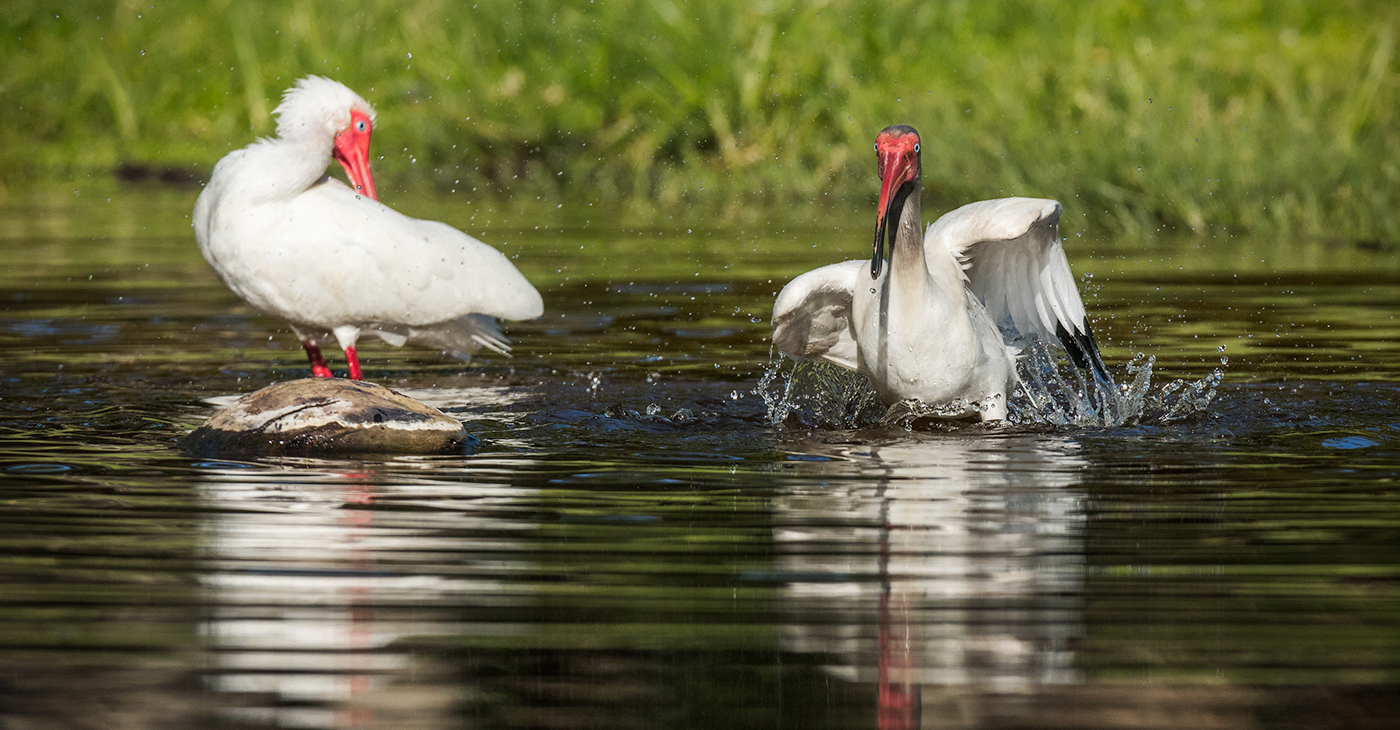
Adult and juvenile Ibis bathing
When the Ibis are ready to breed, their legs, beaks and lores turn from salmon color (back, left bird) to a deep red (front pair).

Bathing Ibis trio
The bathing gets quite exuberant.

The University of Miami Hurricanes mascot is the White Ibis. The story is the Ibis are the last to leave and first to return after a hurricane. Another story is the University of Miami colors of orange, white and green come from the Ibis. You can see this fellow showing off its irridesent green wingtips.

Ibis wingspread
The clean Ibis is ready for its close-up.

Anhingas are one of the more curious birds you'll encounter. We called them snake birds when I was growing up for their ability to swim mostly underwater with just their long, thin neck above water. Once out of the water, they spread their wings wide to dry since they lack the oils of most water birds that keeps water off feathers.
Here are some today from Shark Valley, Everglades National Park. I'm hoping to see many more tomorrow on the aptly named Anhinga Trail.

Anhinga trying to swallow dinner
You can see the fish working its way down the neck, while this male Anhinga tries to figure out what is left dangling off its beak and how to get it off.

Anhinga, Shark Valley, Everglades National Park
This Anhinga chick is trying out its wings and should be flying for the first time in a day or two.

Anhinga chick in sunset light
Common birds can be engaging subjects. While looking for some Sandhill Cranes in a winter farm field, I came across these Canada Geese.

Stoic Canada Geese
European starlings were introduced to North America allegedly by 19th Century Shakespeare fans, since the birds were mentioned in his work. One of nature's amazing sights is a starling murmuration. If you've never seen a flock morphing into amazing shapes as it flies, google the term, sit back, and be amazed.

European Starlings
Red Wing Blackbirds also gather in huge flocks and create murmurations. You can find another image from this flock in National Geographic's Backyard Guide to Birds of North America. It is quite exciting to get a call from NG asking to purchase rights to a couple of your photos!

Blackbird murmuration, LaSalle County, Illinois
No, this isn't a review of the Oscar nominated film -- but it is a terrific movie. Just been watching the Olympics and thinking about the trip this week last winter to Yellowstone and Grand Tetons National Parks to enjoy snowy activities, so here is a collection of some folks getting out in the snow and ice.

Ice sailing, Northerly Island, Chicago
This fellow was ice sailing over the flats of Northerly Island. You can see the former air traffic control building right behind him when this was Meigs Field and then Soldier Field to the left.

Ice climbing, LaSalle Canyon, Starved Rock State Park
When it's cold enough--which is happening less and less--people get out to climb the ice falls at Starved Rock.

Observation Point, Old Faithful Geyser basin
This is more my speed. Snowshoeing to Observation Point to look down on Old Faithful geyser.

Snow sled line, Yellowstone
If you want some horse power assist, snow sleds are an option.
Or if you want a different source of horse power . . .

Horse drawn sleigh, National Elk Refuge, Wyoming
There's just something about covered bridges. There are few remaining in Illinois. Just southeast of Springfield in Glenarm is Sugar Creek bridge built in 1880.

Sugar Creek covered bridge, Sangamon County, Illinois
Our biggest snowfall last night has closed schools, courts, and offices for the first time in a few years. It seems appropriate to visit some snow scenes from Mt. Rainer National Park.

Nisqually River Valley, Mt. Rainer National Park
The glacier carved valley on the southern slope of Mt. Rainer leads up to the what remains of the glacier today.

Paradise, Mt. Rainer National Park, Washington
Paradise averages 54 feet of snow a year, and fog keeps the peak of Mt. Rainer hidden.

Ascending Mt. Rainer
Skiers undertaking an ascent of the mountain.
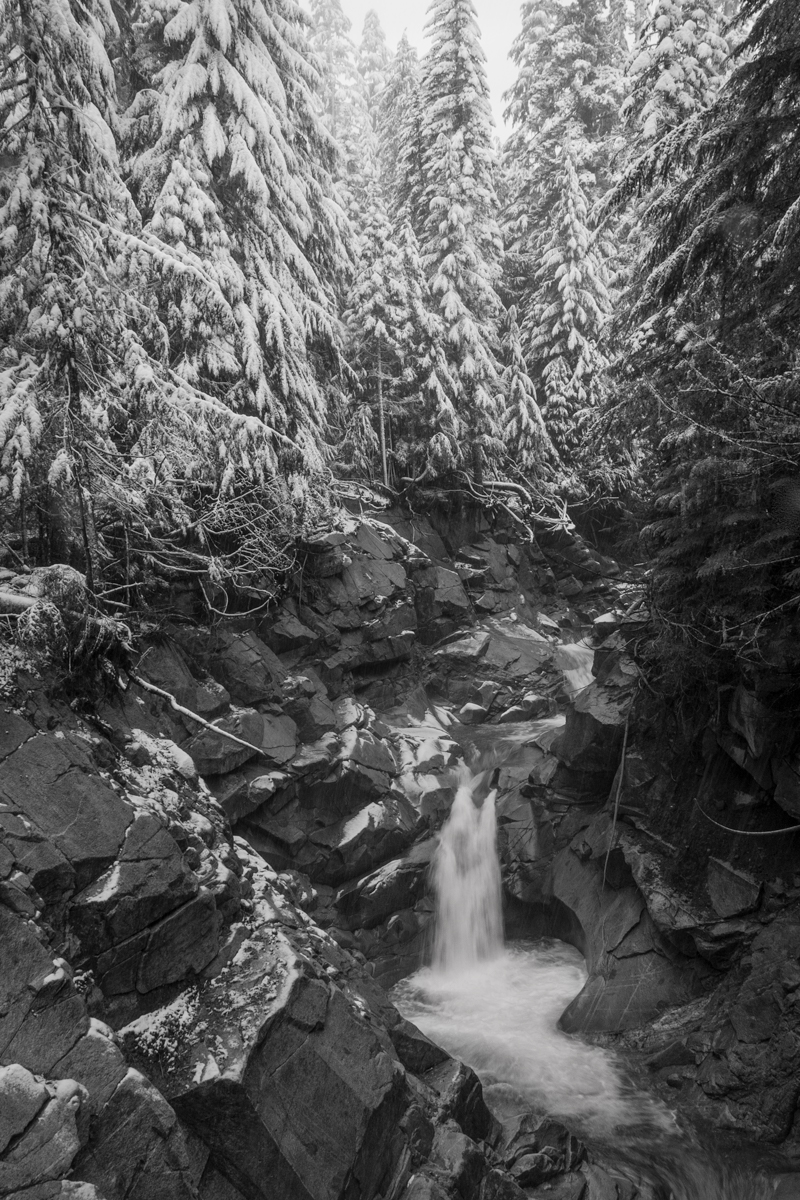
Christine Falls, Mt. Rainer
New snow at Christine Falls made getting to a view to photograph a bit challenging, but well worth the trek.
Merritt Island National Wildlife Refuge is on Cape Canaveral between the Indian River lagoon and the Atlantic Ocean. The Indian River is one of the most productive, diverse lagoons running along much of the east coast of Florida. This fellow is cast netting for some dinner at sunset.

Cast netting Indian River lagoon
East of the river is a complex system of wetlands and barrier islands called Cape Canaveral. The Kennedy Space Center and Merritt Island National Wildlife Refuge are home to mangroves and lots of alligators, manatees, bobcats,wintering birds, and assorted other critters.

Blue hour dusk, Merritt Island National Wildlife Refuge, Florida
Along the coast is Canaveral National Seashore. Jutting well out into the water, it was undoubtedly seen by Ponce de Leon. While long thought he first landed north near St. Augustine 500 years ago, it is now believed it was just south of here.
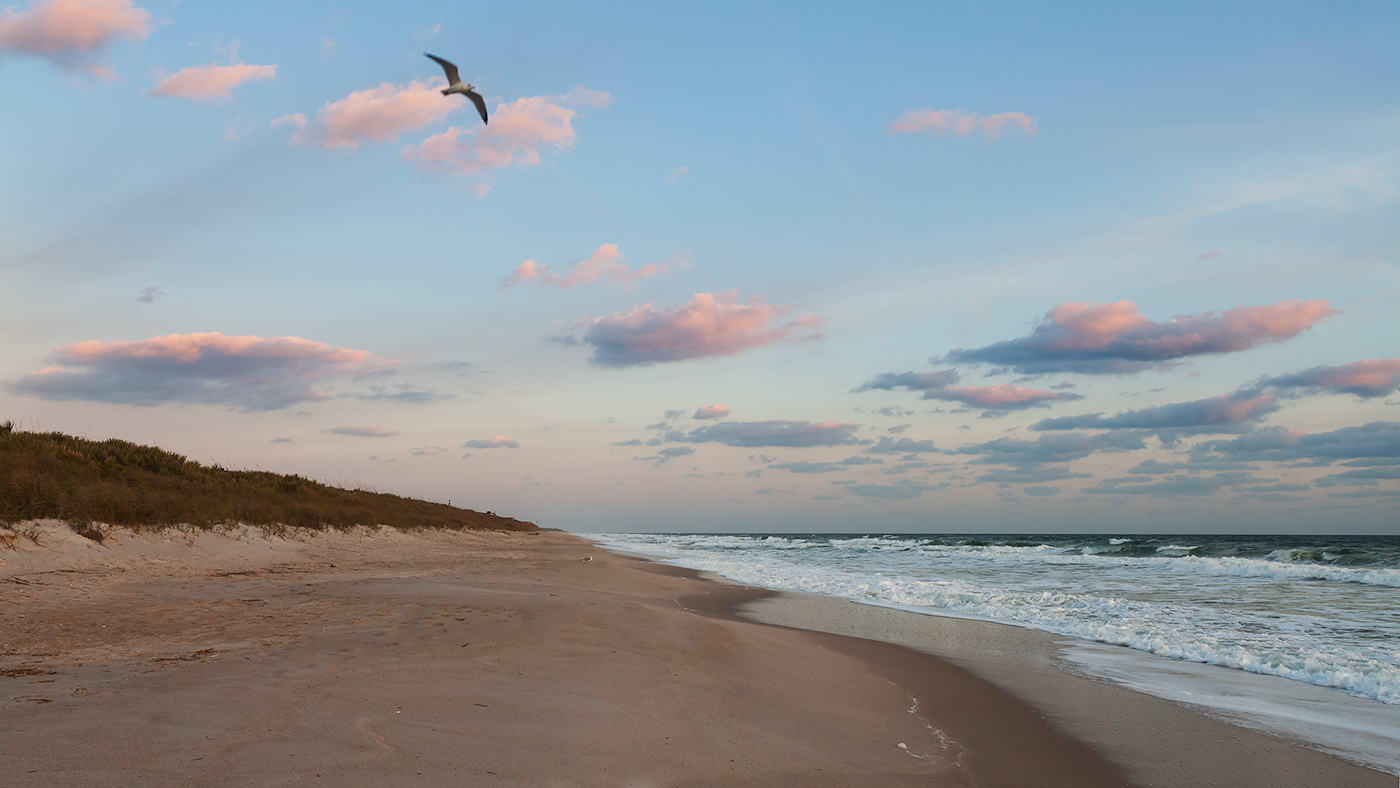
Canaveral National Seashore
I had the pleasure this week of attending the opening of a pop-up exhibit of Glenn Hansen's Time Well Spent photo exhibit at the McAninch Arts Center at College of DuPage. Glenn is former president of the College of DuPage Faculty Association and photography professor. The exhibition closes Saturday, and he has a gallery talk at 1 p.m. If you are in the area, I encourage you to see this wonderful display of 40 years of work.
I was particularly inspired by the portion of the collection he titled View from the Shoulder, of images of the Western U.S. from the roadside. It made me want to get on the road out west. He's got a few of those posted in the High Plains page on his website www.glennhansen.com. Even better, see the prints!
Here are some of my stops along the road.

ranchland, Highway 89, Wyoming

Government Creek Road, Billings County, North Dakota

Carrizozo, Route 54, New Mexico
If you see this place while driving on Route 54 in New Mexico, stop across the street for a Green Chili Burger . . . and a cold beer.

Church Rock, Route 191, Utah
My mother grew up on the Iron Range in northern Minnesota. She would tell stories of deep, long winters there. Unfortunately, I've never been there in deep winter, but winter lasts so long that I got a taste of it in early spring a few years ago. The lakes stay frozen a looonnngg time.
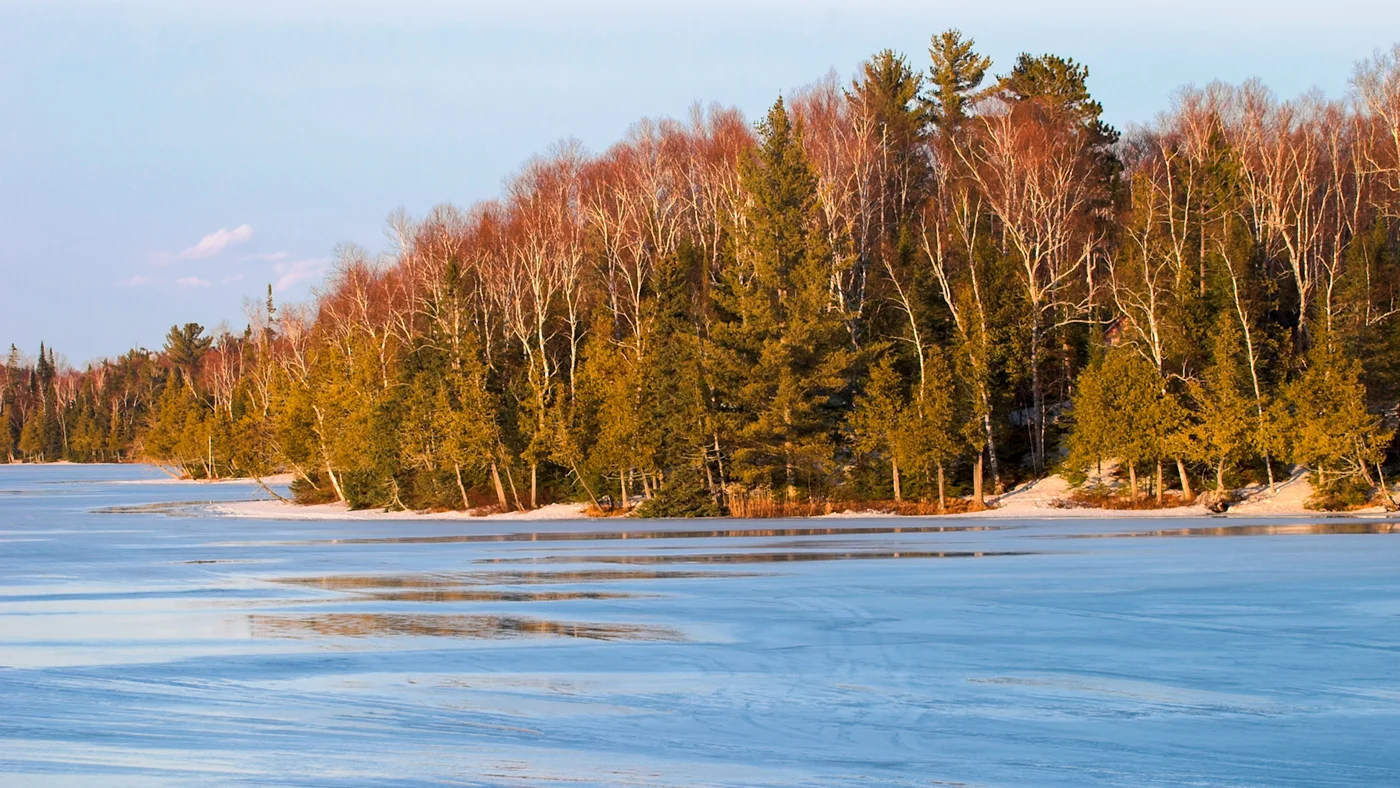
Bear Lake State Park, Minnesota

Bear Lake through the birches
Not far from the Iron Range is the dramatic North Shore of Lake Superior. An iconic view there is Split Rock Lighthouse.

Split Rock Lighthouse
A series of state parks line the coast. This is a view of Shovel Point in Tettegouche State Park. I learned a costly lesson here about securely balancing your tripod on uneven, rocky ground.

Shovel Point, Tettegouche State Park, Minnesota
The Firehole River in Yellowstone National Park must be one of the most aptly named bodies of water. It enters the Upper Geyser basin just behind Old Faithful through a heavy forest.

Geyser Hill trail across Firehole River
It loses tree cover as it enters the Upper Geyser basin.

Upper Geyser Basin, Yellowstone National Park
Super heated water from thermal features enter the river. The constant temperature is a home to a multitude of colorful thermophile (heat loving) bacteria. The River runs near iconic Old Faithful Lodge.

Old Faithful Lodge
Bison graze for meager food along the warm banks of the river. The river is only 21 miles long as it flows from the Continental Divide, into the Madison River which is one of the three main tributaries of the Missouri which joins the Mississippi as the longest river system in the contintent.

Bison along the Firehole River
I usually choose a nature scene for my Friday Foto posts. But most of my time is spent in the urban environment of downtown Chicago. So for the end of the year, I'll post some of my favorite shots when I had my camera downtown this year.

Chase Bank, Dearborn Street
First, a trip along Dearnborn Street. Look up near Madison and you get this view. Down the block is great local hat store.

Optimo Hats, Dearborn Street
Heading north, you get to the Chicago River.

Dearborn Street Bridge, Chicago Riverwalk
Then crossing the river on the Michigan Avenue bridge with the Tribune Tower and Wrigley Building.

Michigan Avenue bridge in the Windy City
It seems some of my favorites this year were of bridges on the river. Sunrise on LSD.
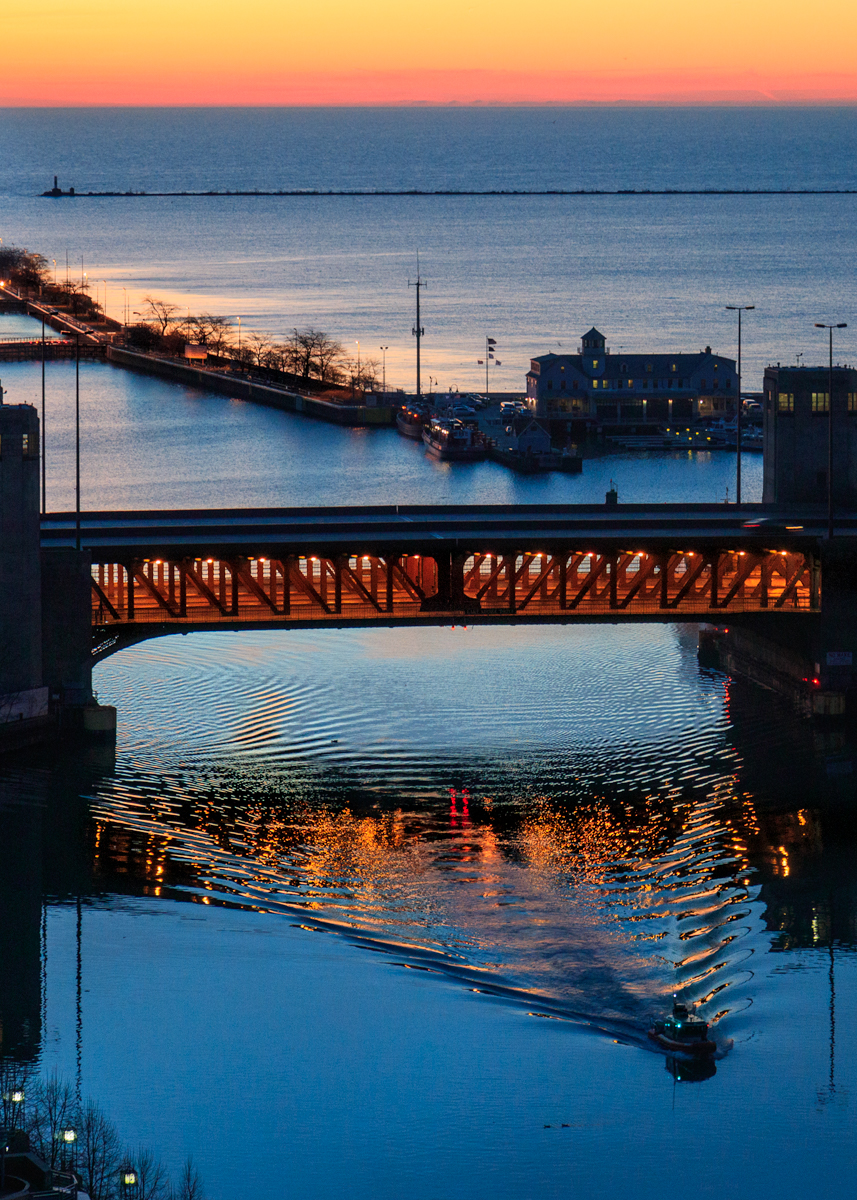
Lake Shore Drive bridge sunrise

Merchandise Mart Elevated Train stop
OK, the last bridge shot is of the El going over the river.
Time for some cold weather looking out over Lake Michigan from Northerly Island.

Lighthouse and water crib Lake Michigan from Northerly Island
A final view back at the skyline on a cold, December morning.

December skyline
The press has been reporting stories of Snowy Owl incursion from their Arctic home into the upper Midwest this year. Ornithologists still don't seem to know with certainty why these incursions occur. The theory used to be that lemming and other rodent population in the north crashed sending the owls south to find food. The current theory is that a large lemming population in the Spring led to a lot of owl births and so the young move south into new territory because of the large numbers. In 2010 there was an incursion of Great Grey Owls and my son Dan and I traveled to Minnesota and were fortunate to find some.

Great Gray Owl, Aitken County, Minnesota
A few years ago, I read reports of a Great Horned Owl nest in St. Cloud, Florida when I was visiting and was fortunate to have one of the chicks raise its head above the feathers from leftover food its parents brought.

Great Horned Owl chick, St. Cloud, FL
One of my favorite encounters with an owl was finding a Burrowing Owl on a hike in Florida. Unfortunately, I can't find the images. Grrr. I did find this image of a captive Eastern Screech Owl that was being rescued in St. Augustine, FL.
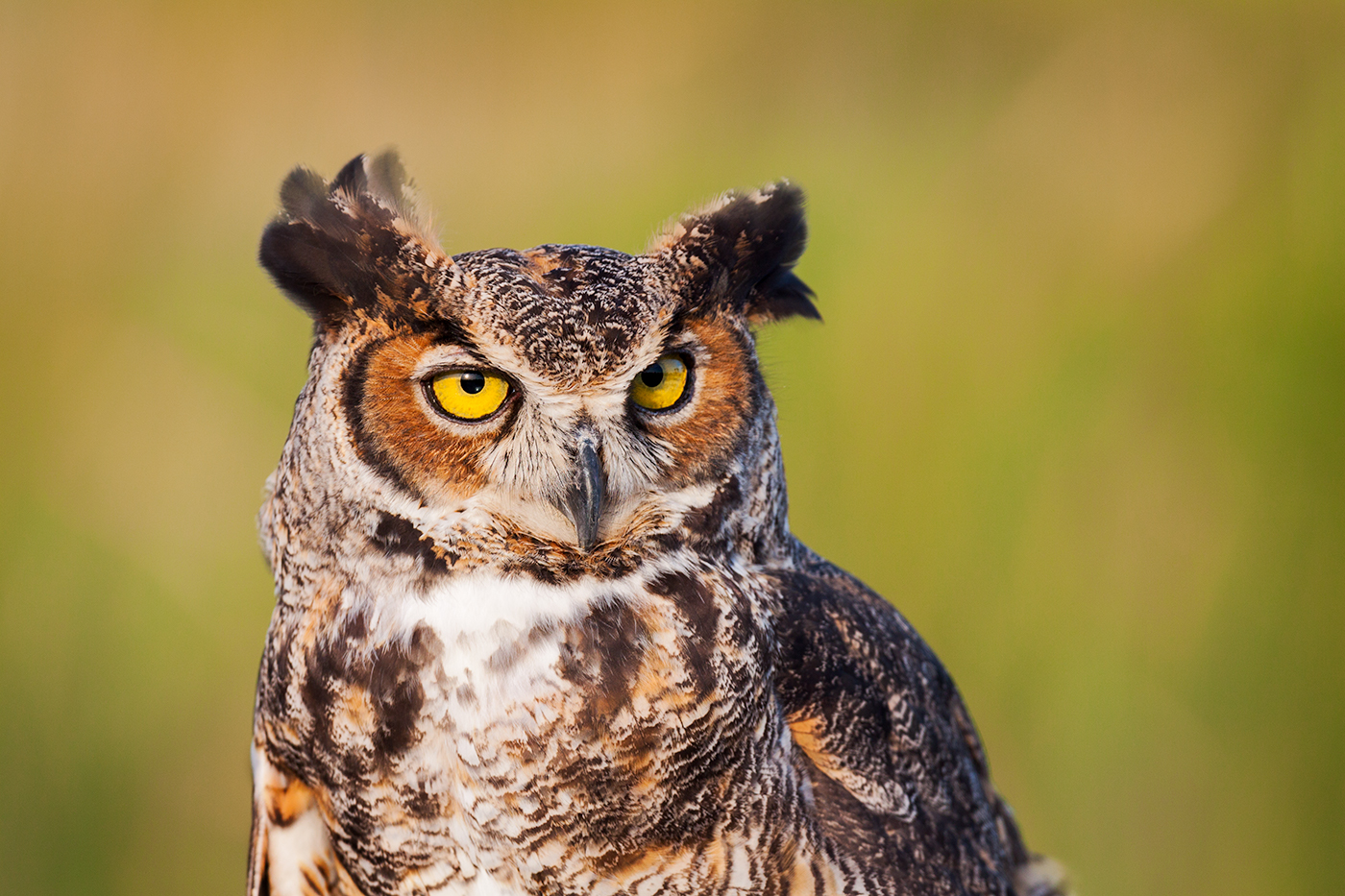
Eastern Screech Owl
When Snowy Owls had an incursion a few years ago that went down to Florida, one found a good source of food among the rodents and other creatures at Montrose Harbor in Chicago. I was not locating it, when in the distance I saw a white bird flying. As I looked through my lens, it flew toward me, until it got so close I couldn't focus and it flew a few feet next to me. What a first encounter! I got some good flight shots and then this one when it landed nearby. If you find reports of Snowies in your area this year, I hope you can find one of these magnificent creatures.

Snowy Owl, Montrose Harbor, Chicago, IL
A small herd of bison spent the night on a small rise near Old Faithful geyser where the snow was melted because of the thermal feature underground. The constant mist from the geysers covered the bison in frost as they huddled together.
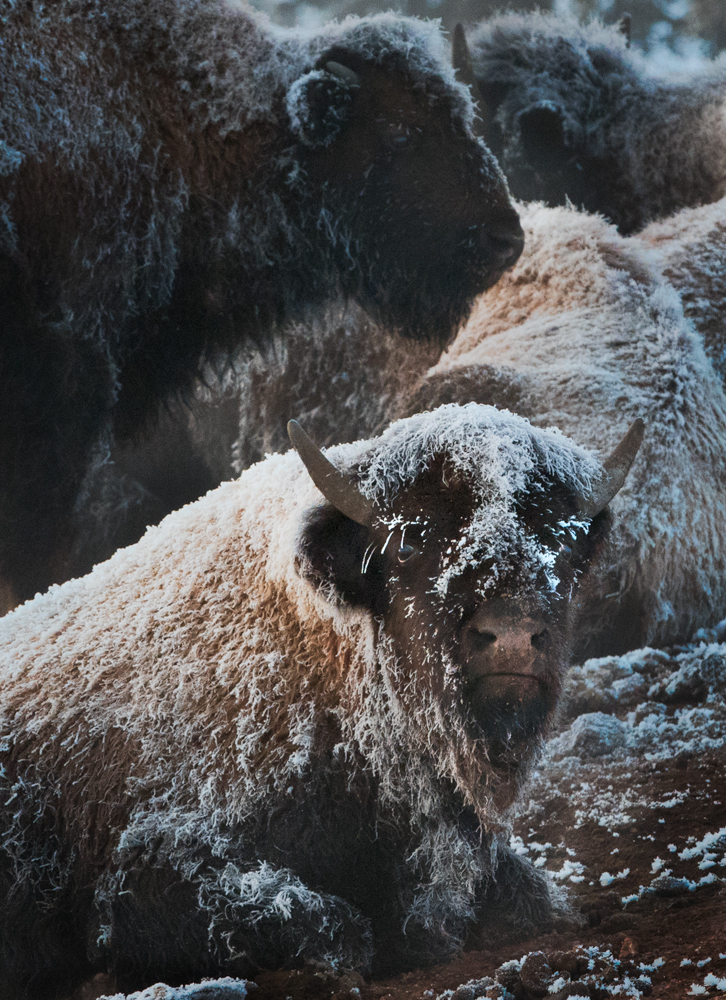
Frosty cow bison
The bison began to rise along with sun to move to new ground.

Frost-covered yearling
A path was soon created as the herd moved into the valley.

Bull and cows plow through the snow
Soon much of the herd were heading in the valley along the tree line.

Winter line of bison, Yellowstone National Park, Wyoming
One mother and her calf, who insisted on milk, remained behind as the sun got higher in the sky behind the mist of Old Faithful.

Sunrise, Old Faithful Geyser
The Antiquities Act became law in 1906 in significant part to protect ancient American archaeologic sites as well as vast natural areas such as Grand Canyon. The Act gives presidents power to designate and protect these national treasures as National Monuments. Navajo National Monument was created in 1909 by President Howard Taft to protect these remote ruins from further destruction by vandals and souvenir hunters.
The red rocks that make up the geography of this area reflect their color back up to the clouds.

Navajo National Monument, Arizona
Betatakin cliff dwelling and Keet Seel are two major protected sites in the monument. The surrounding protection also prohibits mineral exploration and extraction. President Trump's removal of similar protection from most of Bears Ears and Grand Escalante National Monuments this week allow mineral extraction such as fracking which results in increased seismic activity which will destroy nearby ruins.
The pinyon pine nuts were a significant part of the ancient culture that lived here. When we visited, the nuts were ripe. Just outside the park, many people were harvesting in the pinyon forests surrounding the area.

Pinyon pine
Unfortunately, our short visit did not allow us to reserve a ranger led hike in Betatakin as the people in this image were enjoying.

Betatakin alcove hike